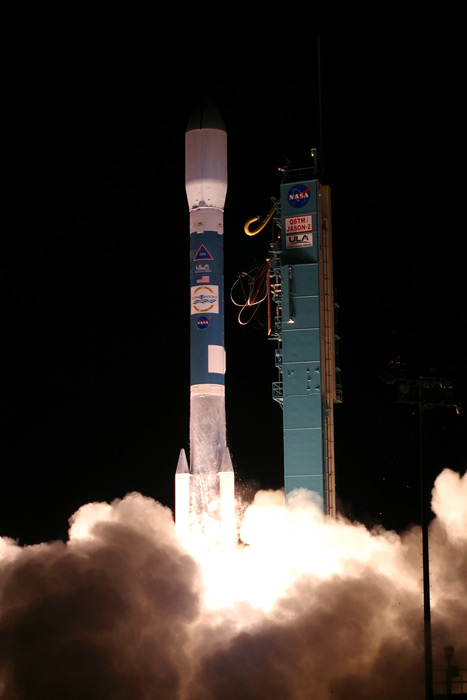NASA Launches New Satellite to Map Rising Seas

PARIS — TheU.S.-European Jason-2 ocean altimetry satellite was launched successfully June20 aboard a Delta 2 rocket from Vandenberg Air Force Base, Calif., on afive-year mission to continue the uninterrupted study of ocean levels andcurrents that was begun in the early 1990s in a U.S.-French partnership.
The launchfeatured the use of a video camera mounted on the Delta 2 upper stage andtrained on the Jason-2satellite to beam live images of the satellite's separation from the rocketand the deployment of its two solar arrays.
NASAspokesman Alan Buis said that while a similar camera angle has been used oncebefore on a Delta 2 mission, the Jason-2 launch was the first time a live videostream from a Delta 2 captured solar-panel deployment.
Buildingupon the work of its Topex-Poseidon and Jason-1 predecessors, built for theFrench space agency, CNES, and NASA, Jason-2 has the added support of the U.S.and European meteorological agencies. The National Oceanic and AtmosphericAdministration (NOAA) and its European counterpart, the 21-nation Eumetsat,each made financial contributions to Jason-2, a demonstration of the increasingnumber of military and civil organizations that make regular use of ocean-altimetry.
The growingpopulation of Jason data users has made clear that, in order to justifyinvesting in future applications, it needs to be assured that there will be nointerruption of altimetry data. This remains a weak point in the Jason program.
Topex-Poseidonwas launched in 1992 on a mission designed to last between three and fiveyears. It ended up functioning for more than a decade, meaning the delays inthe launch of Jason-1 in 2001 did not cause gaps in data gathering.
Similarly,Jason-1 was designed to operate for five years but has remained healthy to thisday.
Get the Space.com Newsletter
Breaking space news, the latest updates on rocket launches, skywatching events and more!
Jason-2also is designedto last five years, and as of now there is no firm decision on a Jason-3.NASA has said that, as a research agency, its job is not to produce multiplecopies of the same hardware. It will not be taking part in any future Jasonmissions.
CNES hasadopted the same view as NASA, but has said it has a spare model of the samesatellite platform used for Jason-2 and is willing to contribute that to aJason-3 effort. NOAA and Eumetsat have indicated they likely will supportJason-3 but have made no formal commitments.
- New Video: Jason 2 Satellite Watches Rising Seas
- New Images: STS-124 Launch Day for Shuttle Discovery
- Video: Shuttle Discovery's Space Station Victory Lap
Join our Space Forums to keep talking space on the latest missions, night sky and more! And if you have a news tip, correction or comment, let us know at: community@space.com.

Charles Q. Choi is a contributing writer for Space.com and Live Science. He covers all things human origins and astronomy as well as physics, animals and general science topics. Charles has a Master of Arts degree from the University of Missouri-Columbia, School of Journalism and a Bachelor of Arts degree from the University of South Florida. Charles has visited every continent on Earth, drinking rancid yak butter tea in Lhasa, snorkeling with sea lions in the Galapagos and even climbing an iceberg in Antarctica. Visit him at http://www.sciwriter.us









